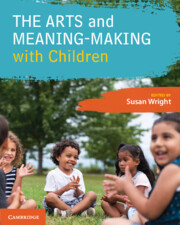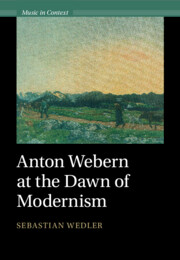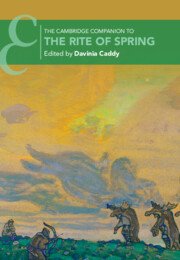Refine search
Actions for selected content:
429 results
Chapter 5 - Meaning expression through music in teacher–child interactions
-
-
- Book:
- The Arts and Meaning-Making with Children
- Published online:
- 11 September 2025
- Print publication:
- 25 September 2025, pp 92-112
-
- Chapter
- Export citation

The Arts and Meaning-Making with Children
-
- Published online:
- 11 September 2025
- Print publication:
- 25 September 2025
-
- Textbook
- Export citation

Anton Webern at the Dawn of Modernism
-
- Published online:
- 21 August 2025
- Print publication:
- 04 September 2025
4 - Reading Ulysses Historically
-
-
- Book:
- The Cambridge Companion to James Joyce
- Published online:
- 14 August 2025
- Print publication:
- 21 August 2025, pp 64-83
-
- Chapter
- Export citation
‘Psychiatry and Songs’: An Appreciation of Dr Niall Crumlish (1974–2025)
-
- Journal:
- Irish Journal of Psychological Medicine , First View
- Published online by Cambridge University Press:
- 21 August 2025, pp. 1-3
-
- Article
-
- You have access
- HTML
- Export citation
11 - Express Yourself
- from Part III - Applications of Rap
-
-
- Book:
- The Cambridge Companion to Global Rap
- Published online:
- 25 July 2025
- Print publication:
- 14 August 2025, pp 168-180
-
- Chapter
- Export citation
16 - Drill as Cultural Form
- from Part IV - Contexts for Rap
-
-
- Book:
- The Cambridge Companion to Global Rap
- Published online:
- 25 July 2025
- Print publication:
- 14 August 2025, pp 236-248
-
- Chapter
- Export citation
8 - Toxteth 1981
-
- Book:
- Dreams and Songs to Sing
- Published online:
- 07 August 2025
- Print publication:
- 07 August 2025, pp 142-165
-
- Chapter
- Export citation
Introduction
-
- Book:
- Teaching the Arts
- Published online:
- 28 July 2025
- Print publication:
- 06 August 2025, pp 1-2
-
- Chapter
- Export citation
Chapter 7 - Learning in music
- from Part 2 - What: the arts learning areas
-
- Book:
- Teaching the Arts
- Published online:
- 28 July 2025
- Print publication:
- 06 August 2025, pp 205-234
-
- Chapter
- Export citation
Performing royal piety: Wajid ‘Ali Shah’s Muharram commemorations in colonial Calcutta
-
- Journal:
- Journal of the Royal Asiatic Society , First View
- Published online by Cambridge University Press:
- 05 August 2025, pp. 1-18
-
- Article
-
- You have access
- Open access
- HTML
- Export citation
Listening to Shaykh Imam: Music, National Belonging, and the Egyptian Left
-
- Journal:
- International Journal of Middle East Studies , First View
- Published online by Cambridge University Press:
- 04 August 2025, pp. 1-23
-
- Article
-
- You have access
- Open access
- HTML
- Export citation
Con y sin uniforme: La música de militares activos y retirados en Colombia
-
- Journal:
- Latin American Research Review ,
- Published online by Cambridge University Press:
- 31 July 2025, pp. 1-23
-
- Article
-
- You have access
- Open access
- HTML
- Export citation

Teaching the Arts
- Early Childhood and Primary Education
-
- Published online:
- 28 July 2025
- Print publication:
- 06 August 2025
-
- Textbook
- Export citation
Introduction: On Criticism, Excess and Felt Response
-
-
- Book:
- The Cambridge Companion to <i>The Rite of Spring</i>
- Published online:
- 28 June 2025
- Print publication:
- 17 July 2025, pp 1-8
-
- Chapter
-
- You have access
- HTML
- Export citation
Austrian World Practices: The Vienna Philharmonic and the Global History of Austrian Culture in the Twentieth Century
-
- Journal:
- Central European History , First View
- Published online by Cambridge University Press:
- 15 July 2025, pp. 1-23
-
- Article
-
- You have access
- Open access
- HTML
- Export citation
Evidence for stress in Filipino text-setting
-
- Article
-
- You have access
- Open access
- HTML
- Export citation
Subjective selection, super-attractors, and the origins of the cultural manifold
-
- Journal:
- Behavioral and Brain Sciences / Accepted manuscript
- Published online by Cambridge University Press:
- 01 July 2025, pp. 1-59
-
- Article
- Export citation

The Cambridge Companion to The Rite of Spring
-
- Published online:
- 28 June 2025
- Print publication:
- 17 July 2025
4 - ‘It’s the Way I Empty What Is Inside of Me’: Occupied Masculinities, Emotional Expression, and Rap Music in a Palestinian Refugee Camp
-
- Book:
- Occupier and Occupied
- Published online:
- 15 June 2025
- Print publication:
- 26 June 2025, pp 94-107
-
- Chapter
- Export citation
